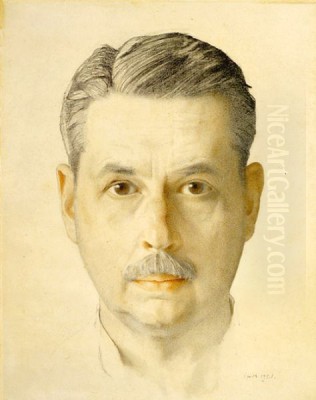
Konstantin Andreevich Somov, born on November 30, 1869, in St. Petersburg, and passing away on May 6, 1939, in Paris, stands as a pivotal figure in Russian art history. He was a distinguished Symbolist painter, a masterful illustrator, and a sensitive landscape artist. Crucially, Somov was one of the founding members of the influential "Mir iskusstva" (World of Art) association, a movement that profoundly shaped the course of Russian modernism at the turn of the 20th century. His legacy is marked by a unique blend of nostalgic elegance, symbolic depth, and technical refinement.
Early Life and Artistic Formation
Somov's journey into the world of art began in an environment steeped in culture and creativity. His father, Andrei Ivanovich Somov, was a respected art historian and served as the senior curator of the Hermitage Museum in St. Petersburg. This familial connection to the arts undoubtedly nurtured young Konstantin's burgeoning talent. He reportedly began drawing and painting at the tender age of six, indicating an early and innate inclination towards visual expression.
His formal artistic education commenced at the prestigious St. Petersburg Academy of Arts, where he enrolled between 1888 and 1897. During his time at the Academy, he studied under the towering figure of Russian Realism, Ilya Repin. While Repin's influence provided a strong foundation in academic technique, Somov's artistic path would ultimately diverge towards more modern and symbolic modes of expression. It was also during these formative years that he forged crucial friendships with fellow students who would become significant figures in the Russian cultural landscape, including the artist and critic Alexander Benois and the sculptor Feodor Dalí. These connections laid the groundwork for future collaborations and artistic dialogues.
Seeking broader horizons and exposure to contemporary European art movements, Somov traveled to Paris in 1897. There, he honed his skills further, studying at the Académie Colarossi under Félix Colarossi and reportedly also receiving instruction from William Ashworth. This period abroad was instrumental in shaping his mature style, allowing him to absorb the influences of French art, particularly the elegance of the 18th century and the burgeoning Art Nouveau aesthetic, while refining his own unique artistic voice.
The World of Art (Mir iskusstva)
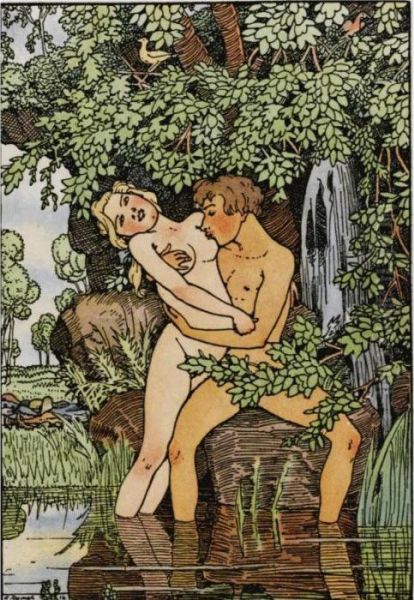
Upon his return to Russia, Somov became a central figure in the formation and activities of the "Mir iskusstva" group. This association, founded in the late 1890s, brought together artists, writers, and critics who sought to revitalize Russian art by embracing aestheticism, historical styles, and a synthesis of different art forms, moving away from the civic-minded Realism that had dominated the previous generation. Somov, alongside Alexander Benois, Leon Bakst, and the impresario Sergei Diaghilev, was instrumental in shaping the group's direction and aesthetic.
The "Mir iskusstva" circle was more than just an artistic collective; it was a vibrant cultural hub. Walter Nouvel, an editor for the group's eponymous magazine, frequently invited Somov to musical evenings and cultural gatherings, fostering a rich intellectual and social environment. Somov's relationship with Sergei Diaghilev was particularly significant, though complex. They were close friends and collaborators, with Diaghilev playing a crucial role in promoting the group's artists, including Somov, both in Russia and internationally through exhibitions and the Ballets Russes. However, personal dynamics, including those involving another member, Dmitry Filosofov, sometimes introduced elements of tension.
Other key figures associated with Somov within this milieu included the artist and critic Nikolai Punin and the artist Ivan Martynenko. Together, these individuals championed a vision of art that valued beauty, craftsmanship, and artistic freedom. Somov contributed significantly to the "Mir iskusstva" journal, not only through his artwork but also through his engagement with the group's ideals. His involvement cemented his position as a leading proponent of Russian Symbolism and modernism.
Artistic Style and Influences
Konstantin Somov's artistic style is a sophisticated tapestry woven from diverse threads, primarily Symbolism, Art Nouveau, and a deep fascination with the aesthetics of the 18th century, particularly French Rococo. His work is characterized by meticulous draftsmanship, delicate and harmonious color palettes, and an exquisite sensitivity to light and shadow. He possessed a remarkable ability to imbue his scenes, whether landscapes, interiors, or portraits, with a palpable atmosphere, often tinged with nostalgia, melancholy, or subtle irony.
Symbolism forms the bedrock of his oeuvre. His paintings frequently transcend mere representation, employing visual metaphors to explore themes of beauty, transience, love, and the enigmatic nature of human emotion. This is evident in his romanticized landscapes, which often feel dreamlike and poetic, evoking a sense of longing for a bygone era or an idealized state of being. The influence of French Rococo artists is palpable in his depictions of gallant scenes, masked figures, harlequins, and elegant ladies, often rendered with a light, playful touch that sometimes veers into gentle satire or eroticism.
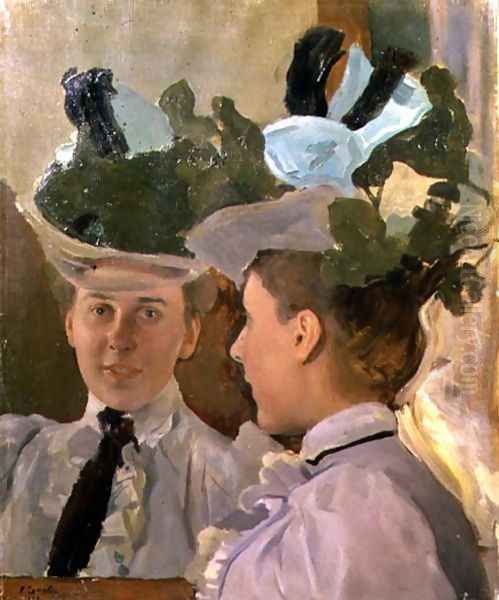
The sinuous lines, decorative patterns, and emphasis on refined aesthetics characteristic of the international Art Nouveau movement also find expression in Somov's work. This is particularly noticeable in his graphic works and illustrations, but also informs the compositional elegance of his paintings. He masterfully integrated figures within decorative settings, creating unified and visually captivating images.
Somov openly acknowledged his artistic debts. He admired the atmospheric effects achieved by the English landscape master J.M.W. William Turner, whose influence can be discerned in the handling of light and color in some of Somov's own landscapes. He also drew inspiration from French Romantic painters like Eugène Delacroix and Camille Corot, as well as the modernist innovations of Édouard Manet. Furthermore, his engagement with earlier art is highlighted by the acknowledged influence of a 17th-century print, Narcissus by Jaspar de Isaac, on his painting Rest after a Walk. This eclectic blend of influences, filtered through his unique sensibility, resulted in a style that was both historically informed and distinctly modern.
Major Themes and Representative Works
Somov's artistic output explored several recurring themes, revealing his preoccupations and stylistic range. He excelled in portraiture, capturing not just the likeness but also the inner world of his sitters, often members of the St. Petersburg intelligentsia and artistic circles. His landscapes, frequently depicting serene park settings, moonlit nights, or idyllic country estates, convey a sense of poetic reverie and nostalgia. Interiors, like the evocative Interior at Pavlov’s Dacha (1899), are rendered with meticulous detail and often carry symbolic weight.
A significant portion of his work reflects a fascination with the 18th century, portraying scenes of aristocratic leisure, masquerades, and amorous encounters. These works often possess a theatrical quality, blurring the lines between reality and fantasy, sincerity and artifice. This interest also extended to his highly regarded work as an illustrator and graphic artist.
Among his most celebrated paintings is The Rainbow (1927). This luminous work, depicting figures in a landscape beneath a vibrant rainbow, showcases his mastery of color and light and achieved remarkable success at auction, setting a record for the artist in the mid-2000s. Lady in Blue (1903), a portrait inspired by 18th-century conventions, exemplifies his ability to blend historical homage with modern sensibility, capturing the sitter's elegance and enigmatic presence.

Other key works include the tranquil landscape Summer Evening. Pond (1897), the sun-drenched Summer Noon (1905), the intimate Sleeping Young Woman in the Park (1897), and the compositionally innovative Open Door on a Garden (1905), which merges still life and landscape elements. His portrait of the Symbolist poet Alexander Blok is another significant work, capturing the intense intellectualism of the era.
Somov's contribution to book illustration was also substantial. He created designs and illustrations for seminal works of Russian literature, including Alexander Pushkin's Eugene Onegin and writings by Nikolai Gogol. His illustrations for Vladimir Nabokov's Lolita are also noted. Perhaps his most famous contribution in this field is the Le Livre de la Marquise (Book of Marquises), a collection of 18th-century French erotic texts for which he provided exquisite Rococo-inspired illustrations, showcasing his wit and decorative flair. His graphic art also included woodcuts, such as the elegant Lady At the Mirror (1898).
Personal Life, Diaries, and Identity
Konstantin Somov's personal life, particularly his identity as a homosexual man in a society that did not openly accept it, profoundly informed his art and experiences. While not overtly political in his work, scholars suggest that his sometimes unflattering or stylized depictions of female figures might reflect his personal orientation. More significantly, his private diaries, which he began keeping meticulously from the age of 25, offer invaluable insights into his thoughts, feelings, artistic process, and relationships.
These diaries reveal a man of complex emotions and sharp intellect, candidly discussing his attractions, his social interactions within the artistic elite, and his views on art and politics. They document his early, albeit brief, romantic involvement with fellow student Dmitry Filosofov, a relationship reportedly viewed with hostility by Sergei Diaghilev, who later became Filosofov's close companion. The diaries also record a later, intense but short-lived affair in 1931 with a young actor named Nikolay Poznyakov, for whom Somov created five distinct portraits during their relationship. They also shed light on his interactions with figures like Mikhail Kuznetsov, whom Diaghilev apparently introduced to Somov, possibly with matchmaking intentions.
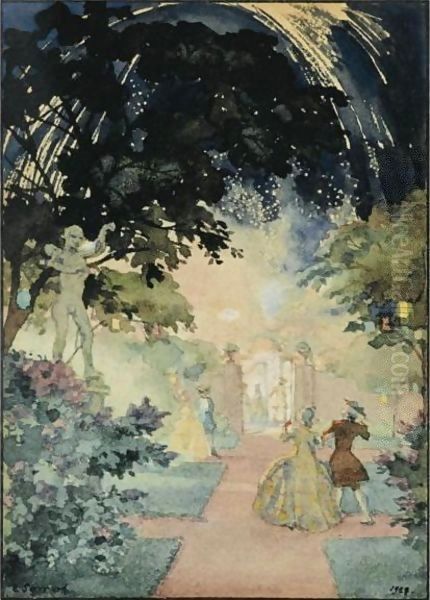
The fate of Somov's diaries adds another layer of complexity. After his death, Soviet editors published selections from his writings, but significantly censored passages related to his homosexuality and potentially politically sensitive comments. This act of expurgation distorted the public understanding of Somov's personality and arguably obscured aspects crucial to interpreting his art. Fortunately, contemporary scholars, such as Pavel Golubev, are undertaking the task of studying and publishing more complete, multi-volume, and uncensored versions of these vital documents, promising a fuller understanding of the artist's life and work.
Emigration and Later Career
The tumultuous events of the Russian Revolution and its aftermath led Somov, like many artists and intellectuals of his generation, to leave his homeland. In 1923, he traveled to the United States as a representative for a major exhibition of Russian art. However, he chose not to return to the Soviet Union. Instead, he made his way to France, a country whose culture and art had long captivated him.
He settled permanently in Paris in 1925, where he spent the remainder of his life. Far from retiring, Somov continued to work actively, painting, drawing, and engaging with the émigré community and the broader European art scene. While perhaps less connected to the avant-garde developments of the time, he maintained his distinctive style, continuing to produce refined portraits, landscapes, and genre scenes.
During his lifetime, Somov enjoyed considerable recognition abroad, arguably more so than in post-Revolutionary Russia, where his perceived aristocratic and aestheticist leanings were out of step with the prevailing socialist realism. His work was particularly well-received in Germany, where exhibitions of his art were held. His decision to remain in exile allowed him to maintain his artistic independence, though it also meant a degree of separation from the cultural context that had initially shaped him. He continued to publish works and participate in the artistic life of Paris until his death in 1939.
Exhibitions and Collections
Konstantin Somov's works have been featured in numerous exhibitions both during his lifetime and posthumously, affirming his status in Russian and European art history. His paintings and graphic works are held in the collections of major international museums. In Russia, key institutions housing his art include the State Tretyakov Gallery in Moscow and the State Russian Museum in St. Petersburg.
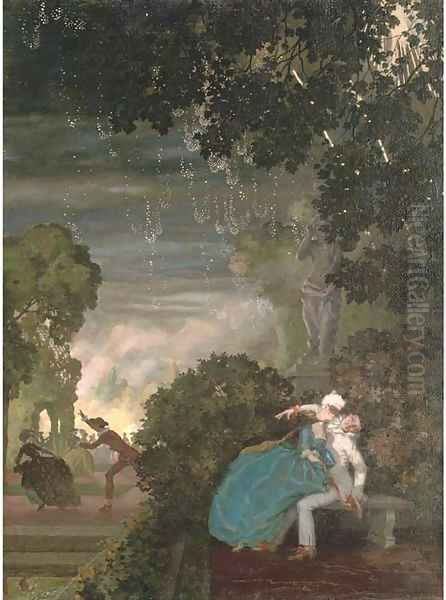
Internationally, his presence is marked by holdings in prestigious museums such as the Musée d'Orsay in Paris and Berlin's Gemäldegalerie. His works frequently appear at auction, often commanding high prices, which speaks to his enduring appeal among collectors. The record-breaking sale of The Rainbow at Christie's in London during their Russian Art Week auctions (reportedly achieving $7.433 million around 2006-2007) underscores the significant market value attached to his major pieces.
Exhibitions dedicated to his work or featuring him prominently continue to be organized. A notable recent example was the "Uncensored" exhibition held at the Odessa Art Museum in Ukraine in 2019, which showcased his paintings and graphic works, potentially highlighting aspects less explored previously. Earlier in his career, his participation in exhibitions in Paris and Berlin helped establish his reputation outside Russia. These exhibitions and permanent collections ensure that Somov's art remains accessible to the public and continues to be studied and appreciated.
Legacy and Scholarly Reception
Konstantin Somov occupies a significant and unique place in the history of Russian art. As a founding member of the "Mir iskusstva" movement, he was at the forefront of the shift away from 19th-century Realism towards modernism, Symbolism, and aestheticism. His work embodies the movement's ideals: a reverence for artistic craftsmanship, an interest in historical styles (particularly the 18th century), and a belief in the synthesis of arts, evident in his equal mastery of painting, drawing, and illustration.
His artistic influence lies in his distinctive stylistic synthesis, blending Russian sensibilities with European influences ranging from Rococo elegance to the atmospheric qualities of Turner and the symbolic depth of contemporary movements. He created a highly personal visual language characterized by refinement, technical brilliance, and an often elusive emotional tone – a mix of nostalgia, irony, and poetic sensitivity. His portraits, landscapes, and genre scenes continue to captivate viewers with their beauty and psychological nuance.
Scholarly interest in Somov remains strong. His life and work are analyzed through his paintings, drawings, and extensive graphic output. The publication of his letters, diaries, and contemporary accounts, such as the 1979 volume Pisma. Dnevniki. Suzhdeniye sovremennikov (Letters. Diaries. Judgments of Contemporaries), provides crucial primary source material. Ongoing research, particularly the work on his uncensored diaries by scholars like Pavel Golubev, promises to deepen our understanding of his complex personality, his artistic intentions, and his navigation of the cultural and political currents of his time. He is recognized not just as a painter of beautiful surfaces, but as an artist whose work offers subtle commentary on beauty, desire, and the passage of time.
Conclusion
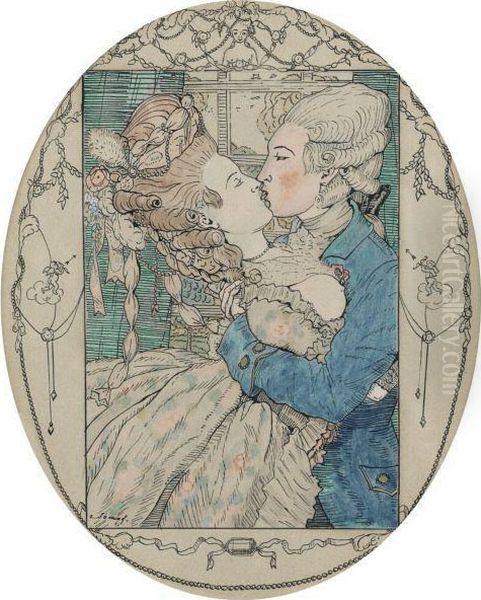
Konstantin Andreevich Somov was a multifaceted artist whose career bridged the Imperial Russian era and the turbulent decades of the early 20th century. A master technician and a subtle Symbolist, he navigated the rich cultural landscape of St. Petersburg's Silver Age as a key member of the influential "Mir iskusstva" circle. His art, characterized by its elegance, historical consciousness, and delicate emotional resonance, reflects a unique fusion of Russian and European artistic traditions. From his evocative portraits and dreamlike landscapes to his witty and refined illustrations, Somov created a body of work that continues to enchant and intrigue, securing his legacy as a significant and enduring figure in modern art history. His life and art, further illuminated by the ongoing study of his personal writings, offer a fascinating window into a pivotal era of artistic transformation.